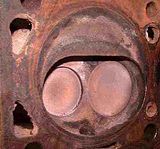I rebuild every head, even race heads with hardened exhaust seats, no professional who is trying to do good work would approach it in any other manner. Valve recession is just the most drastic issue of this unleaded fuel issue. Cast iron exhaust valve seats were never designed to run on hotter burning unleaded fuels. One of the biggest culprits is loss of valve seal, much more common than valve recession, which recession is somewhat rare. What is most common is rapid valve seal loss after a valve job, in which hardened exhaust seats are not used, specifically on cylinder #2 and #3, due to them sharing the same exhaust port . On race cylinder heads, that use leaded race fuel and thru extensive leak down testing, we positively proven that leaded fuel, or lead additive is not the cure once the exhaust seat area material has been compromised by unleaded fuel. You can see when this has happen, by pitting of the exhaust seat area, at this point a typical valve job is useless, and will be very short lived, even with leaded fuel or lead additive.
How strong do I feel about using hardened exhaust seats in my cylinder head rebuilds, so much so if someone called me today and ask me to rebuild their cylinder head,and ask ask me to not use hardened exhaust seats, I would decline the job, because I know there will be hard feelings down the road.
That should explain how I feel about this topic.

 Hi Guest!
Hi Guest!

 smilie in place of the real @
smilie in place of the real @
 Pretty Please - add it to our Events forum(s) and add to the calendar! >>
Pretty Please - add it to our Events forum(s) and add to the calendar! >> 

